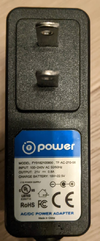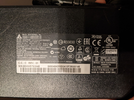Hello friends!
I have a cordless vacuum that has recently stopped being able to charge its battery.
I believe this started happening after I accidentally plugged it into the wrong A/C adapter that had the same plug. (I plugged it into a laptop 19.5v adapter whereas the vacuum's adapter is 19v).
I thought this may have damaged the battery, so I ordered a replacement battery, this one:
https://www.aliexpress.com/item/1005003359507022.html?spm=a2g0s.12269583.0.0.396042b87o645X
The original battery was also a 14.8V "18650" battery, though with a lower mAh rating. The new battery worked well on its initial charge, but exhibited the same charging problem.
When I plug in the vac, it does indicate a charging light and eventually after some time, changes to the "charged" color. However, as soon as you start using the vacuum, it indicates that it has low power and turns off. I assume it is actually low power, since it was able to work fine when the battery had its charge from the factory.
I hooked up the AC adapter to a kill-a-watt and while charging, it's reading a 0.5 amp of power, which seems a bit low (although the adapter says it's rated for 0.8amp), but I assume this means that power is actually flowing.
At this point, I assume the problem must be with the charging electronics - perhaps these were overloaded when hooked up to the laptop's AC adapter. Is there a way to confirm that? If so, is it feasible to repair - e.g. by changing the circuit?
I have a cordless vacuum that has recently stopped being able to charge its battery.
I believe this started happening after I accidentally plugged it into the wrong A/C adapter that had the same plug. (I plugged it into a laptop 19.5v adapter whereas the vacuum's adapter is 19v).
I thought this may have damaged the battery, so I ordered a replacement battery, this one:
https://www.aliexpress.com/item/1005003359507022.html?spm=a2g0s.12269583.0.0.396042b87o645X
The original battery was also a 14.8V "18650" battery, though with a lower mAh rating. The new battery worked well on its initial charge, but exhibited the same charging problem.
When I plug in the vac, it does indicate a charging light and eventually after some time, changes to the "charged" color. However, as soon as you start using the vacuum, it indicates that it has low power and turns off. I assume it is actually low power, since it was able to work fine when the battery had its charge from the factory.
I hooked up the AC adapter to a kill-a-watt and while charging, it's reading a 0.5 amp of power, which seems a bit low (although the adapter says it's rated for 0.8amp), but I assume this means that power is actually flowing.
At this point, I assume the problem must be with the charging electronics - perhaps these were overloaded when hooked up to the laptop's AC adapter. Is there a way to confirm that? If so, is it feasible to repair - e.g. by changing the circuit?
Last edited:



